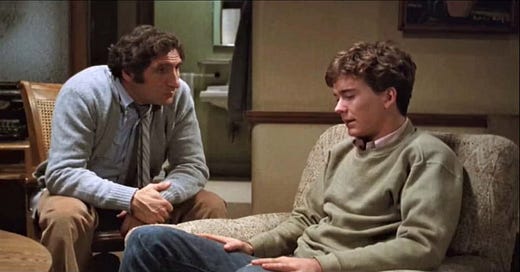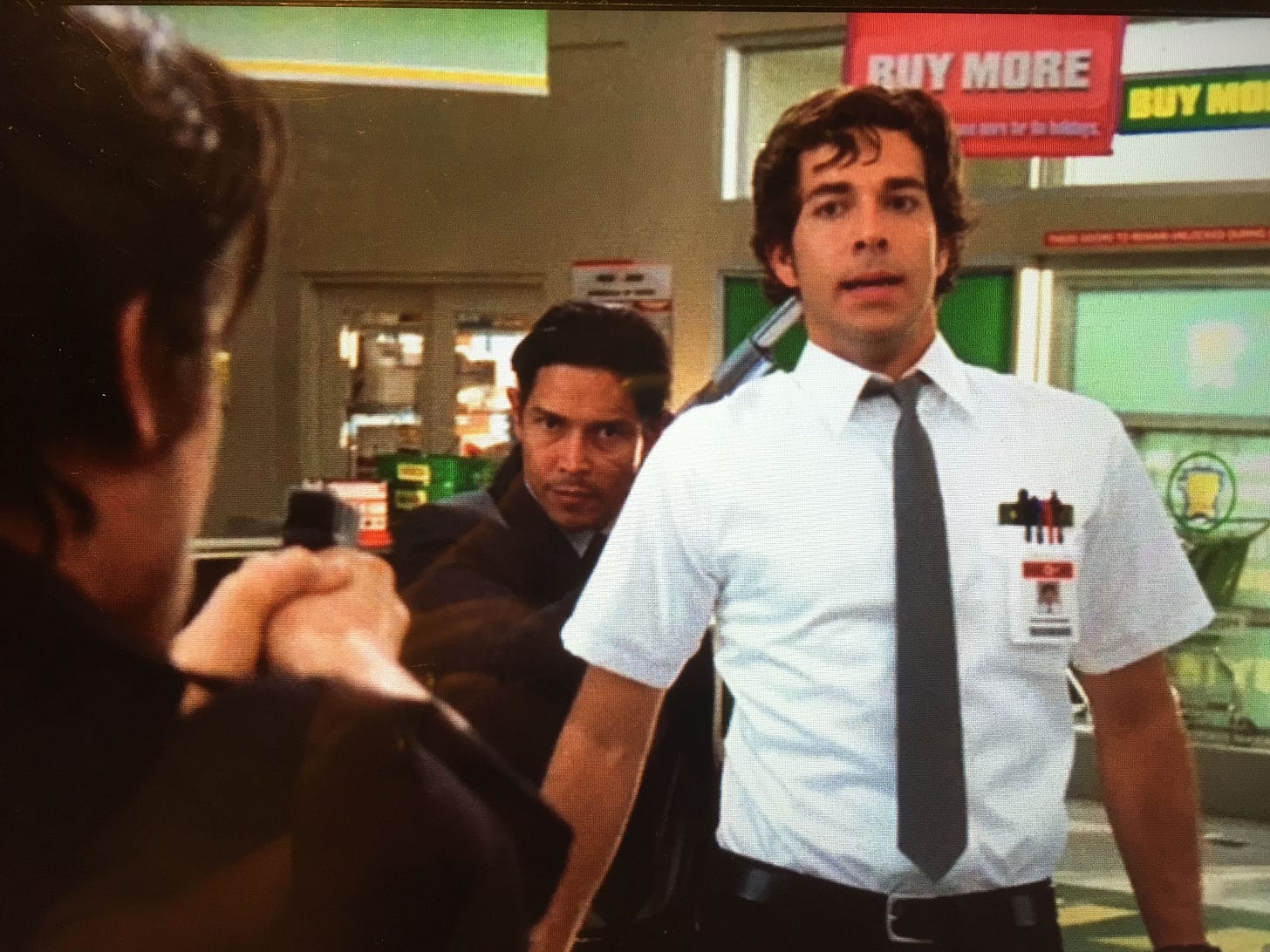Devil's Advocate: Abolishing School Zones
Rebutting arguments made in Speak Truth To Flour's March 4th piece on mental health.
I’m drowning here, and you’re describing the water!
(Melvin Udal, played by Jack Nicholson, “As Good as It Gets”)
With youth anxiety at seemingly unprecedented levels, the March 4, 2024 Speak Truth To Flour piece (“Abolish School Zones”) argued “Today's kids are treading water in life. Time to throw them in the deep end of the pool.”
It’s time to play devil’s advocate.
Geez, if I could get through to you, kiddo, that depression is not sobbing and crying and giving vent, it is plain and simple reduction of feeling. Reduction, see? Of all feeling. People who keep stiff upper lips find that it's damn hard to smile.
(Dr. Berger in Judith Guest’s fiction novel, Ordinary People.)
Free-Range Kids Revisited
March 4th’s post discussed Lenore Skenazy’s 2008 column about letting her nine-year-old ride the subway alone and the importance of letting kids develop independence. 1 Addressing the risk factor, Skenazy wrote:
Was I worried? Yes, a tinge. But it didn’t strike me as that daring, either. Isn’t New York as safe now as it was in 1963? It’s not like we’re living in downtown Baghdad.
That was true in 2008. What about now?
A common claim is that our awareness of bad things happening is on the rise which makes us think there are more bad things happening. That may not be true, especially when it comes to New York.
Skenazy made an interesting assumption about what her child could do if he got lost.
If he couldn’t do that, I trusted him to ask a stranger. And then I even trusted that stranger not to think, “Gee, I was about to catch my train home, but now I think I’ll abduct this adorable child instead.”
In prior generations you could depend on adults to take the initiative to help a child in distress. Now, the bystander effect is amplified by the advent of smartphones and the correlating contemporary compulsion to film or share something that’s happening rather than actually intervene. Keshia Naurana Badalge writes: 2
The act of recording a violent event but staying silent is a modern manifestation of the bystander effect. The bystander effect occurs when people refrain from intervening in an emergency situation because there are other people around. Psychologists Bibb Latané and John Darley, who first demonstrated the bystander effect, attributed this phenomenon to two factors: a perceived diffusion of responsibility (thinking that someone else in the group will help) and social influence (where observers see the inaction of the group as evidence that there is no reason to intervene).
Our camera phones may make us feel like social-media activists, but when we’re recording an event instead of intervening, we’re actually just real-world bystanders. There is a gulf of dissonance between what we publicly declare as our values—online or otherwise—and how we act.
“Abolishing School Zones” 3 discussed how close parents are holding on to their children.
That intimacy and immediacy of information exacerbates the capacity for fear. A University of Michigan Poll revealed that only 33% of parents would allow their 9–11-year-old to walk or bike to a friend’s house. Half of parents would not even let their child find an item in a store on their own if it meant going to a different aisle without them.
This isn’t the 1950’s. Big-box retail stores have replaced most of the small mom-and-pop shops. If you’ve ever had to find someone to assist you with a product at Walmart, you may not have much faith an employee would react or even be around if your child had a problem while in a different aisle.
Even the Buy More in Burbank, with wall-to-wall security cameras and at least two government agents regularly onsite, was no place to leave a child alone.
I’ll Take Therapists for $200
Time for the main course from the original piece; therapy and therapists, or as Sean Connery might say…
Abigail Shrier writes in a The Free Press excerpt from her new book (Bad Therapy: Why the Kids Aren’t Growing Up) about rumination and links that to emotions check-ins at school. 4
There’s another problem posed by emotions check-ins: they tend to induce a state orientation at school, potentially sabotaging kids’ abilities to complete the tasks in front of them.
Some arguments against this would include:
1. There’s no clear brink established for an impact from emotions check-ins and other informal “therapy” in schools. What’s the threshold for when this kind of dialogue would do more harm than good?
2. The benefit of identifying and connecting with a student experiencing substantial mental health issues could outweigh the risk of provoking a negative response in other students who aren’t suffering from significant trauma.
3. How many students are truly being coerced into talking about feelings that they aren’t already dwelling upon? If a student doesn’t wish to explore their feelings, would a simple check-in really prompt them to open up? With the number of students in each class it’s hard to imagine a teacher even having the time to isolate and pressure an individual student to open up if they weren’t already inclined to do so.
Shrier further argues:
But the vast majority are in school, where therapists and non-therapists diagnose kids liberally, and offer in-school counseling and mental health and wellness instruction. By 2022, 96 percent of public schools offered mental health services to students. Many of these interventions constitute what I call “bad therapy”: they target the healthy, inadvertently exacerbating kids’ worry, sadness, and feelings of incapacity.
While on face this sounds incredibly concerning, there’s no warrant for the claim that schools are targeting mentally healthy students. It doesn’t even pass a basic, common-sense test, given the lack of resources combined with school overcrowding. They often operate like a hospital triage, focusing on the most critical cases of students with issues like poor attendance, grades and/or behavior. It is hard to imagine schools looking at the kid from a two-parent home with straight A’s, who is also actively involved in extracurricular activities, and deciding “Yep, that’s the one we need to therapize!”
A core assumption in Shrier’s work is that we are escalating anxiety levels among our youth.
American kids are the freest, most privileged kids in all of history. They are also the saddest, most anxious, depressed, and medicated generation on record. Nearly a third of teen girls say they have seriously considered suicide. For boys, that number is an also alarming 14 percent.
What’s even stranger is that all of these worsening mental health outcomes for kids have coincided with a generation of parents hyper-fixated on the mental health and well-being of their children.
If we were to grant that contemporary schools are focusing on emotions and actively compelling children to disclose their feelings, wouldn’t that distort survey data? Are modern students more anxious and depressed than prior generations or are they just more willing to acknowledge their anxiety than previous generations would?
Finally, let’s assume that this shift to emotion-based learning and increased therapy is causing harm. Does that mean it will always have that effect? When a warehouse makes structural changes to how they pull, pack and ship orders to become more efficient, the immediate result is often that they operate slower than before. Efficiency won’t actually improve until employes have time to adjust to the new environment.
Perhaps it is too soon to make a definitive judgment on how therapy is affecting young people. Students may need more time to adjust to this cultural shift while those administering therapy may need more time to improve execution and develop best practices.
The Only Thing We Have to Fear Itself
The “Abolishing School Zones” column questioned how modern athletes manage adversity and the rise in “opting out.” Mr. Miyagi would not approve.
“It is ok to lose to opponent, must not lose to fear.” However, it’s important to note there is a difference between experiencing stress or anxiety for a time period versus an actual, chronic mental health problem.
Baseball provides countless examples of players who got “the yips” and tried to play through it. Second baseman Chuck Knoblauch lost the ability to make the routine throw to first base. In his playoff debut, pitcher Rick Ankiel imploded during a disastrous third inning with four walks and five wild pitches. He was pulled from the game, unable to complete the inning, and then spent years struggling to throw strikes. Catcher Mackey Sasser had so much difficulty throwing the ball back to the pitcher that he developed a tick where he’d start to pull back his arm to throw before having to put the baseball back into his glove and restart the process again.
Each kept playing and grinding away every day when they probably would have been better off taking a mental break. In the case of Rick Ankiel, it took years and a position change from pitcher to outfielder before he got past it.
On the question of how to promote mental health, the answer isn’t always as easy as simply telling someone to toughen up and get through it. Moreover, there may not be a one size fits all approach.
As Mr. Miyagi would say, “Better learn balance. Balance is key. Balance good, karate good, everything good. Balance bad, better pack up and go home.”
Tip Via BuyMeACoffee.com
https://freerangekids.wordpress.com/2008/04/06/why-i-let-my-9-year-old-ride-the-subway-alone/
Lenore Skenazy, 04/06/2008.
https://qz.com/991167/our-phones-make-us-feel-like-social-media-activists-but-theyre-actually-turning-us-into-bystanders
”Our phones make us feel like social-media activists, but they’re actually turning us into bystanders," Keshia Naurana Badalge, 05/25/2017.
https://speaktruthtoflour.substack.com/p/abolishing-school-zones
”Abolishing School Zones,” Speak Truth To Flour, 03/04/2024.






